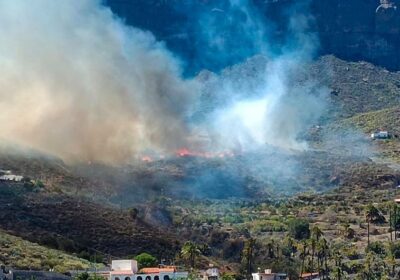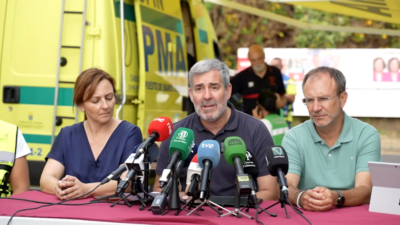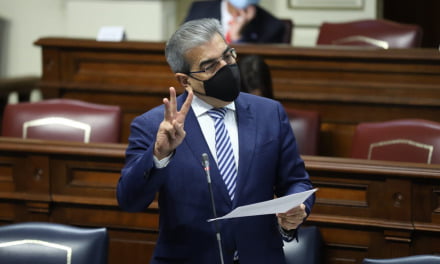It’s been a tense weekend, on The Canary Islands, following a week of intense heat, Saharan dust and very strong winds, blazes broke out on at least 3 islands, the worst of which was a forest fire on La Palma, which may have originated on Friday from the burning of a container at a recreational area. At least that is one of the hypotheses being considered by the Guardia Civil who are now investigating.
Images courtesy of Equipos de Intervención y Refuerzo en Incendios Forestales del Gobierno de Canarias and Acfi Press
 Wildfires also broke on the south of Gran Canaria, in the municipality of San Bartolomé de Tirajana, affecting 5 hectares of grass and scrubland, and on Tenerife, in Arafo, where 30 hectares were burned before being brought under control. The whole archipelago has been on alert, though the danger seems now to be diminishing.
Wildfires also broke on the south of Gran Canaria, in the municipality of San Bartolomé de Tirajana, affecting 5 hectares of grass and scrubland, and on Tenerife, in Arafo, where 30 hectares were burned before being brought under control. The whole archipelago has been on alert, though the danger seems now to be diminishing.The La Palmas fire is believed to have started during a nighttime party, despite the warning not to light fires due to the high temperatures over the weekend.
It has taken three days to even start to control the multiple fronts, with temperatures now dropping and the winds much lighter, the Government of the Canary Islands have this Sunday authorised residents from the areas affected between the LP-1 highway and the coast, to return to their homes, which includes the majority of the affected towns such as Tijarafe and most of the municipality of Puntagorda. However, uphill areas remain closed.
 The newly inaugurated President of the Canary Islands, Fernando Clavijo, emphasised on Sunday that the fire is “not under control” but hoped that the nighttime conditions of temperature and humidity would favour its extinction. He acknowledged that the greatest concern is the flank of the Caldera de Taburiente National Park, an area notoriously difficult to access on foot and where only limited resources have been allocated due to prioritising the defence of populated areas.
The newly inaugurated President of the Canary Islands, Fernando Clavijo, emphasised on Sunday that the fire is “not under control” but hoped that the nighttime conditions of temperature and humidity would favour its extinction. He acknowledged that the greatest concern is the flank of the Caldera de Taburiente National Park, an area notoriously difficult to access on foot and where only limited resources have been allocated due to prioritising the defence of populated areas.
The LP-1 highway remained open for residents returning to their homes until 10:30 p.m. and then reopened this morning at 6:30 a.m. for construction work. The two road accesses to the highest point on the island, the Roque de los Muchachos astronomical observatory, which had been evacuated as a precautionary measure, and were also reopened to traffic.
Throughout Sunday night, 150 ground personnel were tackling the blaze and this morning 550 or so, as well as 10 aerial units, plus one coordination unit, have continued in the firefighting efforts.
 Emergency coordination officials have stated that satellite images are being examined to precisely determine how much area has been affected, as they believe it currently to be around 1,000 hectares, which is smaller than had been previously estimated, at around 4,600 hectares.
Emergency coordination officials have stated that satellite images are being examined to precisely determine how much area has been affected, as they believe it currently to be around 1,000 hectares, which is smaller than had been previously estimated, at around 4,600 hectares.
Among the nighttime personnel were reinforcements from Lanzarote, Fuerteventura, and Gran Canaria, as well as members of the UME Military Emergencies Unit and a team from the Caldera de Taburiente National Park.
Although the front, near Caldera de Taburiente is a concern because resources have not yet been deployed in the area, it has also been observed that the fire is progressing much slower than expected within the National Park. This front will be attacked from the air this Monday as soon as visibility allows, as it is sometimes hindered by clouds and smoke.
150 ground personnel were active during the night.
Nocturnal work focused on the areas of Cruz del Llano, the Izcagua ravine, and El Reventón. “The situation is very different from Saturday,” said Montserrat Román, head of Civil Protection and Emergencies for the Government of the Canary Islands, but she urged caution as the fire remains active and os not yet under control.
The President of the La Palma Island Council, Sergio Rodríguez, also emphasised that “the news is positive,” and stated that when the return of some evacuees is authorised, it is because all safety guarantees are in place.
 “The weather has been favourable, and the emergency teams have been able to work in the areas of most concern, which include residential areas and the southern flank,” explained Rodríguez. No new reports of structures being affected have been provided. The latest data indicates a minimum of twenty, including houses, agricultural buildings, and wineries.
“The weather has been favourable, and the emergency teams have been able to work in the areas of most concern, which include residential areas and the southern flank,” explained Rodríguez. No new reports of structures being affected have been provided. The latest data indicates a minimum of twenty, including houses, agricultural buildings, and wineries.
Nieves Lady Barretto, the Councillor for Presidency, Justice, and Security of the Government of the Canary Islands, explained that on Monday, the third day of the fire, the same operational plan as on Sunday will be deployed, involving 550 ground personnel and eleven aerial units, including a coordination unit.
The forest fire that has been affecting the northwest of La Palma since Saturday, which evolved favourably during the night, but has reactivated in the high part of the municipality of Tijarafe, above the town. Ground and aerial resources are working to prevent this reactivation from consolidating or reaching residential areas.
The director of operations in the Caldera de Taburiente has indicated that the fire entered the National Park on Saturday and is spreading through the area of Lomo de Tenerra and Barranco Bombas de Agua.
After a reconnaissance flight, Ángel Palomares, the director of the National Park, explained that the fire is advancing slowly on the southwestern flank towards Tazacorte, in areas that are not easily accessible and where it is not as widespread as initially thought.
 No personnel will be sent to that area of the Park because, although there is still combustible material, the ravines act as natural firebreaks, and the fire could extinguish itself.
No personnel will be sent to that area of the Park because, although there is still combustible material, the ravines act as natural firebreaks, and the fire could extinguish itself.
Fernando Clavijo expressed gratitude for the messages of support received from King Felipe VI, Prime Minister Pedro Sánchez, and the leader of the People’s Party, Alberto Núñez Feijóo.
The Military Emergencies Unit (UME) will reinforce the support they are providing with an additional 86 personnel flying in from the Morón Air Base in Sevilla.
Rafael García, the director of the firefighting operation, explained that in the Puntagorda area, where the fire originated and where the entire municipality remains evacuated, efforts are focused on cooling down the lower front of the fire to prevent it from spreading to the lower part of the municipality.
In the northern area, the strategy is to prevent the fire from spreading beyond the Izcagua ravine, while in the southern area, helitransport teams and the UME are concentrating on extinguishing the fire up to the area known as El Time.
Aerial resources are being used to contain the spread of the flames in Caldera de Taburiente National Park.
Marta Román, the regional head of Civil Protection and Emergencies, has stated that the LP-1 and LP-4 roads remain closed, and evacuations are ongoing in Puntallana and the Tijarafe area.
She has urged everyone to stay away from the fire zone and to follow the authorities’ instructions at all times.














